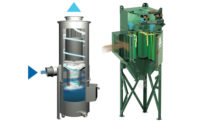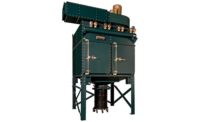Metalworking fluids (MWFs) commonly used during machining processes generate airborne contaminant mists that must be carefully controlled. It is important to understand the hazards associated with oil mists as well as exposure limits set by OSHA and other entities.
A number of adverse health effects are associated with MWF emissions. These include harmful effects to the respiratory system, the digestive tract, skin, the brain and internal organs, as well as immune disorders and potential genetic damage.
OSHA has established personal exposure limits (PELs) to protect workers against many of these health risks, as follows:
- 5 mg/m3 for an 8-hour time-weighted average (TWA) for mineral oil mist
- 15 mg/m3 for an 8-hour TWA for Particulates Not Otherwise Classified
If your facility is meeting OSHA requirements but workers are still experiencing symptoms, it may be necessary to set lower goals. A number of other entities have established threshold limits that are in some cases stricter than OSHA’s – notably, The National Institute for Occupational Safety and Health (NIOSH), and the American Conference of Governmental Hygienists (ACGIH). It’s a good idea to familiarize yourself with the guidelines published by these groups.
There are two general categories of MWFs used in machining processes:
n Emulsion coolants: Water-soluble and water-mixed coolants are cooling lubricant concentrates that are diluted with water up to their usage concentration prior to their use. The oil or lubrication proportion is typically about 5–11 percent. They offer very good heat dissipation and are used primarily for their cooling function.
n Pure or “straight oil” coolants: Non-water-soluble coolants are not mixed with water and are used according to the composition provided by the manufacturer. Straight oil coolants are generally used for their excellent lubricating properties – unlike the water-mixed emulsion compounds which provide some lubrication but are used primarily for cooling.
Mist collector types
A variety of equipment is used to capture mists generated when these coolants and lubricants are used. Most commonly used are multi-stage fiberglass V-bag mist collectors. Also prevalent are centrifugal-type mist collectors that use a rotating drum to spin out the oil.
Both styles of collectors are usually designed for double duty, i.e., they can be used on both straight oil and emulsion coolants. As a rule of thumb, they work well on lighter-duty applications but are not as effective for heavy-duty use and long production runs. V-bag and centrifugal collectors offer relatively low initial cost but are limited in terms of run time, filter service life and filtration efficiencies.
Because of these limitations, many machining center operators recognize that one collector size and type does not fit all. Straight oils and emulsion coolants have very different properties and characteristics. As a result, you may want to consider a collection system that is specifically engineered for use with one type or the other.
Figure 1 shows a high efficiency mist collector designed especially for removal of water-based coolants/emulsions. It uses two stages of long-life coarse and fine filter demisters followed by a final-stage HEPA filter with combined efficiencies of 99.9 percent on particles of 0.3 micron and larger. This is much higher than capture efficiencies achieved with fiberglass V-bag filters. The HEPA filter stage is optional and is typically used where a process is generating smoke or very fine particulate.
Figure 2 shows a mist collector designed for use with pure or straight lubricant oils. A first-stage coarse mesh filter separates out large particles and chips, followed by two stages of diffusion filters: a pre-filter and fine filter. Media separators in the filter packs allow optimum airflow while providing maximum usable media area within a compact space.
This design combines high efficiency separation performance with self-cleaning capability via drainage of the separated cooling lubricant. Benefits include reduced energy consumption, extended filter life, and enhanced protection of the optional HEPA final filter, which may be used for removal of ultra-fine mists and/or clean air recirculation. Achieving separation efficiencies up to 99.97 percent on 0.3 micron and larger particles, it is built to operate “24/7” and to withstand the most challenging applications.
Other equipment considerations
Any time you can reduce the load on a collector, it’s a good thing. Metal chips entering the collector can drastically shorten filter life. A good general rule is to maintain a slight negative pressure when doing machining. This will allow you to capture the fine mist without pulling chips, emulsion or oil into the collector.
Another strategy is to use a special hood or chip gate to separate out chips and pre-clean the oil. Basically it acts like a horizontal cyclone designed for the airflow you need in the machining center. Chip gates can sometimes be retrofitted onto older equipment.
Equip ductwork with proper fittings and seals that are specifically made for oil. Make sure the cabinet is leak-proof and won’t seep oil; otherwise, employees are at risk of slipping and falling on oily floors. Even very small cracks will allow oil to seep out. Use equipment that has been dye-tested and certified as leak-proof by the manufacturer to make sure leaks and cracks don’t occur.
In addition to a guarantee that the collector and its components won’t leak, a reputable manufacturer should also guarantee filter emissions efficiency, to ensure that you keep below required exposure limits. Some manufacturers will also provide written guarantees on filter life and run time to fit your operation.









